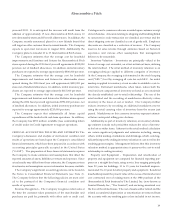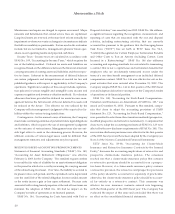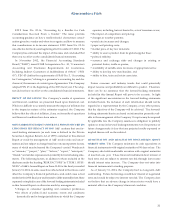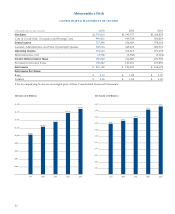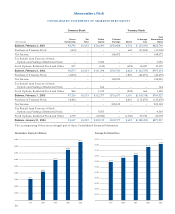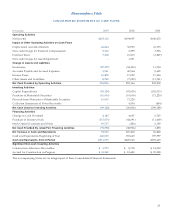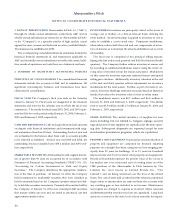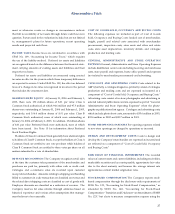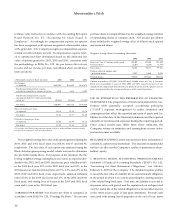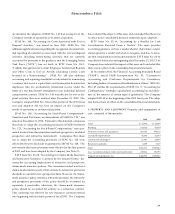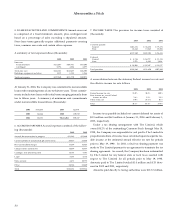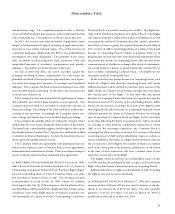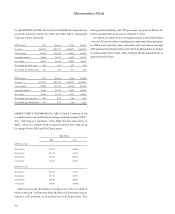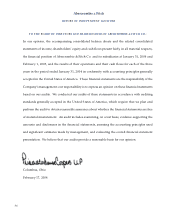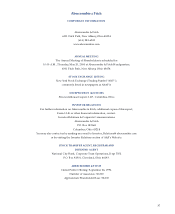Abercrombie & Fitch 2003 Annual Report Download - page 30
Download and view the complete annual report
Please find page 30 of the 2003 Abercrombie & Fitch annual report below. You can navigate through the pages in the report by either clicking on the pages listed below, or by using the keyword search tool below to find specific information within the annual report.
Abercrombie &Fitch
intrinsic value method in accordance with Accounting Principles
Board Opinion No. 25, “Accounting for Stock Issued to
Employees.” Accordingly, no compensation expense for options
has been recognized as all options are granted at fair market value
at the grant date. The Company recognizes compensation expense
related to restricted share awards. If compensation expense relat-
ed to options had been determined based on the estimated fair
value of options granted in 2003, 2002 and 2001, consistent with
the methodology in SFAS No. 123, the pro forma effect on net
income and net income per basic and diluted share would have
been as follows:
(Thousands except per share amount) 2003 2002 2001
Net Income:
As reported $205,102 $194,935 $168,672
Stock-based compensation expense
included in reported net income, net of tax 3,250 1,414 2,401
Stock-based compensation expense
determined under fair value based method,
net of tax(1) (28,261) (28,184) (22,453)
Pro forma $180,091 $168,165 $148,620
Basic net income per share:
As reported $2.12 $1.99 $1.70
Pro forma $1.86 $1.71 $1.50
Diluted net income per share:
As reported $2.06 $1.94 $1.65
Pro forma $1.83 $1.68 $1.48
(1) Includes stock-based compensation expense related to restricted share awards actually
recognized in earnings in each period presented.
The weighted-average fair value of all options granted during the
2003, 2002 and 2001 fiscal years was $14.05, $12.07 and $14.96,
respectively. The fair value of each option was estimated using the
Black-Scholes option-pricing model, which was used to determine
the pro forma results above. For purposes of the valuation, the fol-
lowing weighted-average assumptions were used: no expected divi-
dends in the 2003, 2002 and 2001 fiscal years; price volatility of 64%
in the 2003 fiscal year, 53% in the 2002 fiscal year and 54% in the
2001 fiscal year; risk-free interest rates of 2.5%, 4.3% and 4.7% in the
2003, 2002 and 2001 fiscal years, respectively; assumed forfeiture
rates of 23% in the 2003 fiscal year and 15% in the 2002 and 2001
fiscal years; and vesting lives of 4 years in the 2003 and 2002 fiscal
years and 5 years in the 2001 fiscal year.
EARNINGS PER SHARE Net income per share is computed in
accordance with SFAS No. 128, “Earnings Per Share.” Net income
per basic share is computed based on the weighted-average number
of outstanding shares of common stock. Net income per diluted
share includes the weighted-average effect of dilutive stock options
and restricted shares.
Weighted–Average Shares Outstanding (thousands):
2003 2002 2001
Shares of Class A Common stock issued 103,300 103,300 103,300
Treasury shares (6,467) (5,129) (4,198)
Basic shares 96,833 98,171 99,102
Dilutive effect of options and
restricted shares 2,747 2,460 3,422
Diluted shares 99,580 100,631 102,524
Options to purchase 6,151,000, 9,218,000 and 5,630,000 shares of Class A Common
Stock were outstanding at year-end 2003, 2002 and 2001, respectively, but were not
included in the computation of net income per diluted share because the options’ exercise
prices were greater than the average market price of the underlying shares.
USE OF ESTIMATES IN T HE PREPARAT ION OF F INANCIAL
STATEMENTS The preparation of financial statements in con-
formity with generally accepted accounting principles
(“GAAP”) requires management to make estimates and
assumptions that affect the reported amounts of assets and lia-
bilities as of the date of the financial statements and the reported
amounts of revenues and expenses during the reporting period.
Since actual results may differ from those estimates, the
Company revises its estimates and assumptions as new infor-
mation becomes available.
RECLASSIFICATIONS Certain amounts have been reclassified to
conform to current year presentation. The amounts reclassified did
not have an effect on the Company’s results of operations or share-
holders’ equity.
3. RECENTLY ISSUED ACCOUNTING PRONOUNCEMENTS
Statement of Financial Accounting Standards (“SFAS”) No. 143,
“Accounting for Asset Retirement Obligations,” was effective
February 2, 2003 for the Company. The standard requires entities
to record the fair value of a liability for an asset retirement obligation
in the period in which it is a cost by increasing the carrying amount
of the related long-lived asset. Over time, the liability is accreted to
its present value each period, and the capitalized cost is depreciated
over the useful life of the related obligation for its recorded amount
or the entity incurs a gain or loss upon settlement. Because costs
associated with exiting leased properties at the end of lease terms
28



